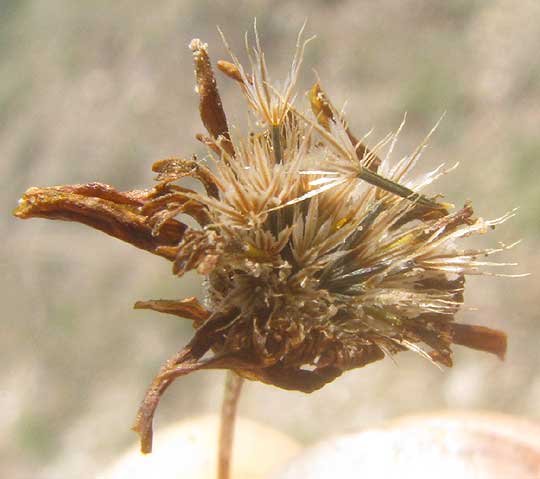Excerpts from Jim Conrad's
Naturalist Newsletter

from the the June 2, 2013 Newsletter issued from the Frio Canyon Nature Education Center in northern Uvalde County, southwestern Texas, on the southern border of the Edwards Plateau; elevation ~1750m (~5750 ft); N29.62°, W99.86°; USA
DOGWEED
In thin, dry soil atop limestone rock and at the edge of gravel roads nowadays there's a tufted, dark green, fine-leafed, ankle-high perennial herb or subshrub -- a member of the huge Composite or Daisy Family -- abundantly and prettily producing golden flowering heads on long, slender peduncles held well above the herbage, as shown above.
So many of our wildflower species are golden-headed members of the Composite Family that it's hard to keep them all separated. Seeing this one for the first time I knew I'd have to seriously "do the botany," and when I do that, usually the first step is to turn a flowering head over and see what the green, scale-like "phyllaries" forming the cuplike involucre at the head's bottom looks like. You can see what I saw there below:

Two items are especially noteworthy there. First, the lower, outer phyllaries are much shorter than the upper, inner ones. Second, each phyllary is equipped with one or a few oblong, somewhat glistening, fairly hard to see golden glands. Having glandular phyllaries is a good field mark.
Breaking open a flower head for a longitudinal section, I found what's shown below:

The little platform the individual flowers stand upon, the receptacle, is convex instead of flat, so that's something. More important, though, is that no scale-like bracts appear between the individual disk flowers -- no paleae. A large percentage of Composite Family flowering heads do provide paleae between their disk flowers, so that's a major point.
Also, atop each dark, future fruit, or cypsela, the "pappus" consists of ten sharp-pointed, miniscule scales that hardly show up in the photograph. However, the scales that are hard to see on the flowers enlarge considerably to become parts of the future cypsela-type-fruit's "parachute," which helps with wind dispersal. Already certain flowering heads are in fruit so we can see what becomes of these ten tiny scales atop each cypsela, as shown in a mature head below:

There you can see that the individual segments of the parachute aren't mere slender hairs, as in the case of Dandelions or asters, but are really sharp-pointed, broad-based scales, and that there are about ten of them atop each cypsela. These scales are fairly unusual in the family, so they also make good field marks.
The plant form and its leaves also are unusual for this family, as seen below:

The leaves, which are mostly opposite -- two arising at each stem node -- are deeply divided into up to eleven slender, needlelike, somewhat sharp lobes.
So, with these and other observations in mind, the pretty little roadside pincushion plant eventually reveals itself as THYMOPHYLLA PENTACHAETA, which is so attention-getting and widespread in the arid southwestern quarter of the US and arid northern Mexico that it's known by several common names, including Dogweed, Golden Dyssodia and Fiveneedle Pricklyleaf. Also a population lives in Argentina, and it's anyone's guess as to how that happened -- whether naturally or by early human introduction.
The plant is pretty enough that some people grow it in rock gardens. I'll be collecting seeds for germination and passing out plants later.
The online Biblioteca Digital de la Medicina Tradicional Mexicana, which calls it Manzanilla del Monte, reports that the Kikapu people of Mexico's Coahuila State traditionally used tea brewed from the plant for fever and stomach ache.